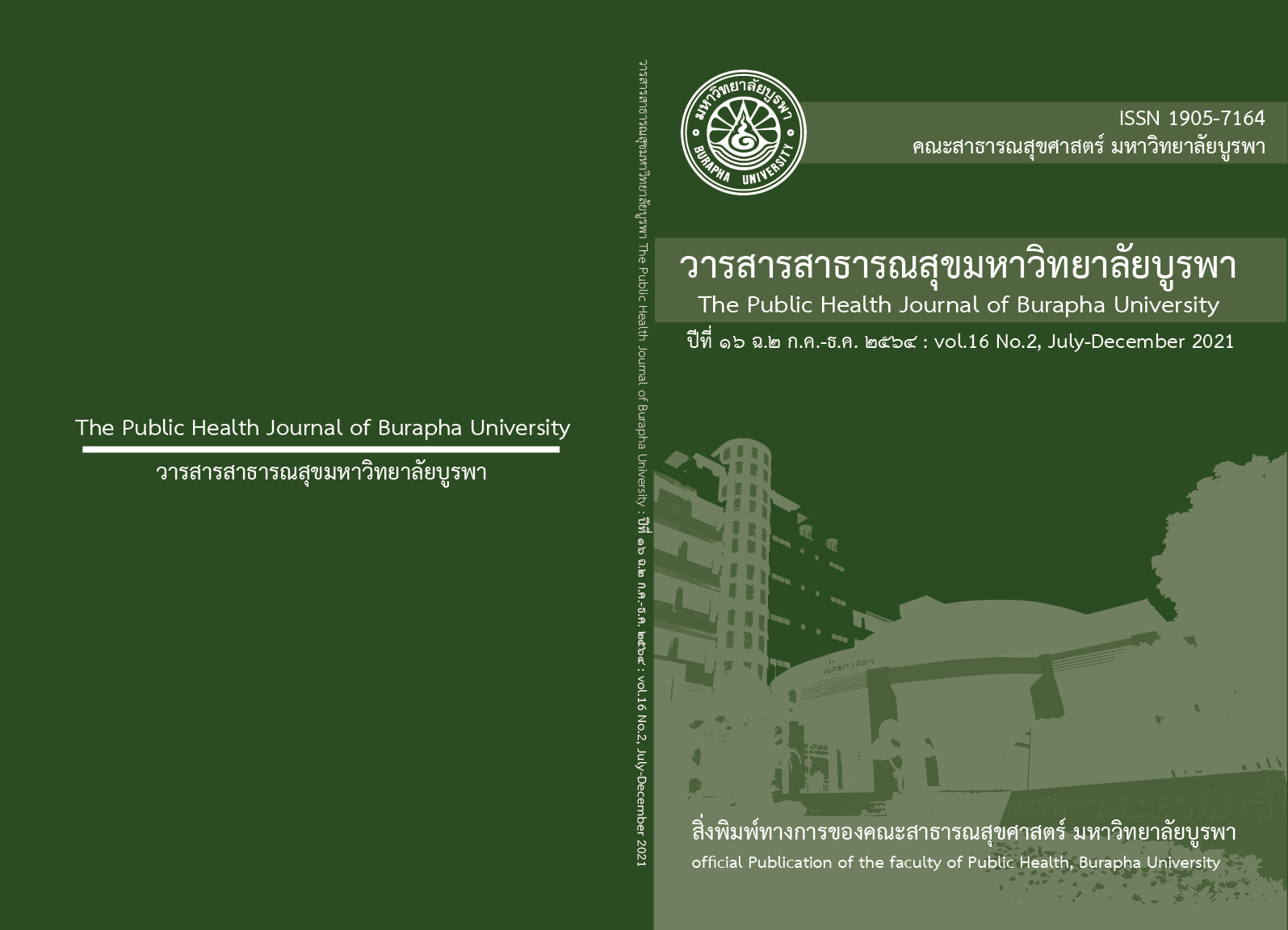การตอบสนองของระบบหัวใจและหลอดเลือดขณะออกกำลังกายแบบเกร็งค้าง ในผู้สูงอายุเบาหวานชนิดที่ 2 ร่วมกับความดันโลหิตสูง: การศึกษานำร่อง
Main Article Content
บทคัดย่อ
ที่มาและความสำคัญ:ภาวะสูงอายุ เบาหวานชนิดที่ 2 และความดันโลหิตสูง ต่างมีการทำงานของระบบประสาท
ซิมพาเทติกสูง ดังนั้นผู้สูงอายุที่มีทั้ง 2 ภาวะร่วมกัน (DM-HT) จึงอาจมีการตอบสนองของหัวใจและหลอดเลือดขณะออกกำลังกายแบบเกร็งค้างเพิ่มมากขึ้น ซึ่งยังไม่เคยมีการศึกษามาก่อน
วัตถุประสงค์:ศึกษาการตอบสนองของหัวใจและหลอดเลือดขณะออกกำลังกายเกร็งค้างในผู้สูงอายุ DM-HT
วิธีการวิจัย: ผู้สูงอายุ DM-HT 10 คน อายุเฉลี่ย 65.6±3.84 ปี ได้รับการทดสอบ exercise pressor responses (EPR) ด้วยการออกกำลังกายบีบมือเกร็งค้างที่ความหนักร้อยละ 30 ของแรงบีบมือสูงสุด และกั้นการไหลเวียนเลือดเมื่อหยุดออกกำลังกายทันที (post exercise circulatory occlusion, PECO) วัดความดันโลหิต (BP) และอัตราการเต้นของหัวใจ (HR) ในระยะพัก ระหว่างออกกำลังกาย และ PECO ระยะละ 2 นาที
ผลการวิจัย: ความดันซิสโตลิกเพิ่มขึ้น 21.7±7.86 มิลลิเมตรปรอท HR เพิ่มขึ้น 4.80 ± 3.55 ครั้ง/นาที ในระหว่างออกกำลังกาย แต่ไม่เปลี่ยนแปลงในระยะ PECO
สรุปผล: การทำงานของหัวใจและหลอดเลือดขณะออกกำลังกายแบบเกร็งค้างเพิ่มมากขึ้นในผู้สูงอายุ DM-HTซึ่งอาจเป็นผลของการเพิ่มขึ้นของระบบประสาทซิมพาเทติกต่อหัวใจมากกว่าหลอดเลือด แต่ควรศึกษาในอาสาสมัครจำนวนมากขึ้น รวมทั้งเปรียบเทียบกับอาสาสมัครสูงอายุสุขภาพดี
Article Details

อนุญาตภายใต้เงื่อนไข Creative Commons Attribution-NonCommercial-NoDerivatives 4.0 International License.
เอกสารอ้างอิง
2. Boer IH, Bangalore S, Benetos A, Davis AM, Michos ED, Muntner P, et al. Diabetes and Hypertension: A Position Statement by the American Diabetes Association. Diabetes Care. 2017;40(9): 1273 - 84.
3. Huggett J, Scott M, Gilbey G, Stoker B, Mackintosh F, Mary G. Impact of Type 2 Diabetes Mellitus on Sympathetic Neural Mechanisms in Hypertension. Circulation. 2003;108(25): 3097 - 101.
4. Murphy MN, Mizuno M, Mitchell JH, Smith SA. Cardiovascular regulation by skeletal muscle reflexes in health and disease. Am J Physiol Heart Circ Physiol. 2011;301(4): 1191 - 204.
5. Esler M, Hastings J, Lambert G, Kaye D, Jennings G, Seals DR. The influence of aging on the human sympathetic nervous system and brain norepinephrine turnover. Am J Physiol Regul Integr Comp Physiol. 2002; 282(3): 909 -16.
6. Fisher JP, White MJ. Muscle afferent contributions to the cardiovascular response to isometric exercise. Exp Physiol. 2004; 89(6): 639 - 46.
7. Ubolsakka-Jones C, Sangthong B, Aueyingsak S, Jones DA. Older women with controlled isolated systolic hypertension: Exercise and blood pressure. Med Sci Sports Exerc. 2016;48(6): 983 - 9.
8. Greaney JL, Matthews EL, Boggs ME, Edwards DG, Duncan RL, Farquhar WB. Exaggerated exercise pressor reflex in adults with moderately elevated systolic blood pressure: role of purinergic receptors. Am J Physiol Heart Circ Physiol. 2014;306(1): 132 - 41.
9. Ubolsakka-Jones C, Sangthong B, Khrisanapant W, Jones DA. The effect of slow-loaded breathing training on the blood pressure response to handgrip exercise in patients with isolated systolic hypertension. Hypertens Res. 2017;40(10): 885 - 91.
10. Petrofsky JS, Stewart B, Patterson C, Cole M, Al Malty A, Lee S. Cardiovascular responses and endurance during isometric exercise in patients with Type 2 diabetes compared to control subjects. Med Sci Monit. 2005;11(10): 470 - 7.
11. Holwerda SW, Restaino RM, Manrique C, Lastra G, Fisher JP, Fadel PJ. Augmented pressor and sympathetic responses to skeletal muscle metaboreflex activation in type 2 diabetes patients. Am J Physiol Heart Circ Physiol. 2016; 310(2): 300 - 9.
12. Al-Sharea, A., Lee, M., Whillas, A., MichellL., Shihata, A., Nicholls, J., et al.,Chronic sympathetic driven hypertension promotes atherosclerosis by enhancing hematopoiesis. Haematologica, 2019; 104(3), 456–67.
13. Boushel R. Muscle metaboreflex control of the circulation during exercise: Muscle metaboreflex during exercise. Acta Physiol. 2010;199(4): 367 - 83.
14. Kaufman MP, Hayes SG. The Exercise Pressor Reflex. Clin Auton Res. 2002;12(6): 429 - 39.
15. Secher NH, Amann M. Human investigations into the exercise pressor reflex: The exercise pressor reflex. Exp Physiol. 2012;97(1): 59 - 69.
16. Delaney EP, Greaney JL, Edwards DG, Rose WC, Fadel PJ, Farquhar WB.Exaggerated sympathetic and pressor responses to handgrip exercise in older hypertensive humans: role of the muscle metaboreflex. Am J Physiol Heart Circ Physiol. 2010 ;299(5): 1318-27.
17.Vranish JR, HolwerdaSW, Kaur J, Fadel PJ. Augmented pressor and sympathoexcitatory responses to the onset of isometric handgrip in patients with type 2 diabetes. Am J Physiol Regul Integr Comp Physiol.2020 ;318(2): 311-9.
18.Cameron JD, JK Cruickshank JK. Arterial function glucose, insulin, diabetes and mechanisms of arterial dysfunction. Clin Exp Pharmacol Physiol 2007;34, 677- 82.
19. HolwerdaW, LuehrsE, DuBoseL, CollinsT, WooldridgeA, StroudK, et al.Elevated muscle sympathetic nerve activity contributes to central artery stiffness in young and middle-age/older adults. Hypertension 2019; 73(5), 1025 - 3.

